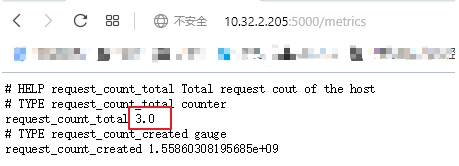prometheus自定义监控指标——实战
上一节介绍了pushgateway的作用、优劣以及部署使用,本机通过几个实例来重温一下自定义监控指标是如何使用的。
一、监控容器启动时间(shell)
使用prometheus已经两个月了,但从未找到容器运行时间的指标(有一个类似的指标是容器创建时间)。学会自定义监控指标后,第一个实例就应该来搞定它。
前提条件是,部署好pushagateway!
在被监控机器上(linux),创建以下脚本
#!/bin/bash
allname=`docker ps --format "{{.Names}}"` #获取所有运行的容器名称
function dockerruntime(){
t=`docker inspect -f '{{.State.StartedAt}}' $1` #获取各个容器的启动时间
t1=`date +%s -d "$t"` #将时间转成时间戳
t2=`date +%s` #获取当前时间的时间戳
let tt=t2-t1 #计算运行时间
echo $tt
}
sudo rm -f a
echo """# TYPE docker_runtime gauge
# HELP docker_runtime time sec""" >> a #将往pushgateway上传的数据写入a文件
for i in ${allname}
do
t=`dockerruntime $i`
echo "docker_runtime{name=\"$i\"} $t" >> a #格式化写入数据 不能使用单引号 会屏蔽$i的
done
curl --data-binary "@a" http://pushgatewayIP:9091/metrics/job/docker_runtime/instance/xa-lsr-billubuntu #修改地址和参数名向特定的url上传数据 数在a文件中
sudo rm -f a #清空临时文件
给该脚本加执行权限,执行后,登陆pushgateway的webUI

可以看到被监控机器给pushgateway,PUSH了数据,意思是在被监控机器上搜索到了三个容器,每个job的名称叫“docker_runtime”
将该脚本加入周期性计划任务中,每分钟执行一次,若对时间有要求,可以将上述脚本稍加修改,每15s或30s执行一次。
此时在prometheus中的query的查询框中输入“docker_runtime”便可获取上述数据。
【注意】
注意上传数据的类型
如果上传的数据类型是 UNTYPE 那么 prometheus将无法识别,导致整个pushgateway数据无法接受!因此需要格外关注发送的数据格式。
数据类型只有四种 counter gauge summary histogram
二、python向pushgateway发送数据
安装prometheus客户端
pip install prometheus_client
1、counter类型
#counter是可增长的,重启时候会被置成0,用于任务个数,只增不减
#使用flask构建一个建议的网页
import prometheus_client
from prometheus_client import Counter
from prometheus_client.core import CollectorRegistry
from flask import Response, Flask
app = Flask(__name__)
requests_total = Counter("request_count", "Total request cout of the host")
@app.route("/metrics")
def requests_count():
requests_total.inc()
# requests_total.inc(2) 每一次刷新会增加2
return Response(prometheus_client.generate_latest(requests_total),
mimetype="text/plain")
@app.route('/')
def index():
requests_total.inc()
return "Hello World"
if __name__ == "__main__":
app.run(host="0.0.0.0")
结果:

2、gauage类型
import prometheus_client
from prometheus_client import Counter,Gauge
from prometheus_client.core import CollectorRegistry
from flask import Response, Flask
app = Flask(__name__)
g = Gauge("random_value", "Random value of the request")
@app.route("/metrics")
def s():
with open("a.txt",'r') as f:
num=f.read()
g.set(num)
return Response(prometheus_client.generate_latest(g),
mimetype="text/plain")
@app.route('/')
def index():
requests_total.inc()
return "Hello World"
if __name__ == "__main__":
app.run(host="0.0.0.0")
结果:

以上作用是在本地生成一个小型网站,下一步是将选定的数据发送到pushgateway
#在被监控机上写python代码
#CollectorRegistry可以同时注册多个自定义指标并返回给prometheus
importprometheus_client
fromprometheus_clientimportGauge
fromprometheus_client.coreimportCollectorRegistry
importrequests
defv1(): #获取监控数据的值
return2.3
defv2():
return3.60
n1=v1()
n2=v2()
REGISTRY=CollectorRegistry(auto_describe=False)
#自定义指标必须利用CollectorRegistry进行注册,注册后返回给prometheus
#CollectorRegistry必须提供register,一个指标收集器可以注册多个collectoryregistry
jin=Gauge("jin_kou","zhegezuoyongshijinkoudaxiao",["l1",'l2','instance'],registry=REGISTRY)
chu=Gauge("chu_kou","zhegezuoyongshichukoudaxiao",["l1",'l2','instance'],registry=REGISTRY)
#“jin_kou” 指标名称
# "zhegezuoyongshichukoudaxiao" 指标的注释信息
# "[]" 定义标签的类别及个数
jin.labels(l1="label1",l2="label2",instance="windows1").inc(n1)
chu.labels(l1="label1",l2="label2",instance="windows1").inc(n2)
#“[]”中有几个,就需要写几个个数要完全一致
requests.post("http://pushgatewayIP:9091/metrics/job/python/",data=prometheus_client.generate_latest(REGISTRY))
#向指定的API发送post信息,将注册的信息发过去
#API中的 “python”是 job的名字
结果:




